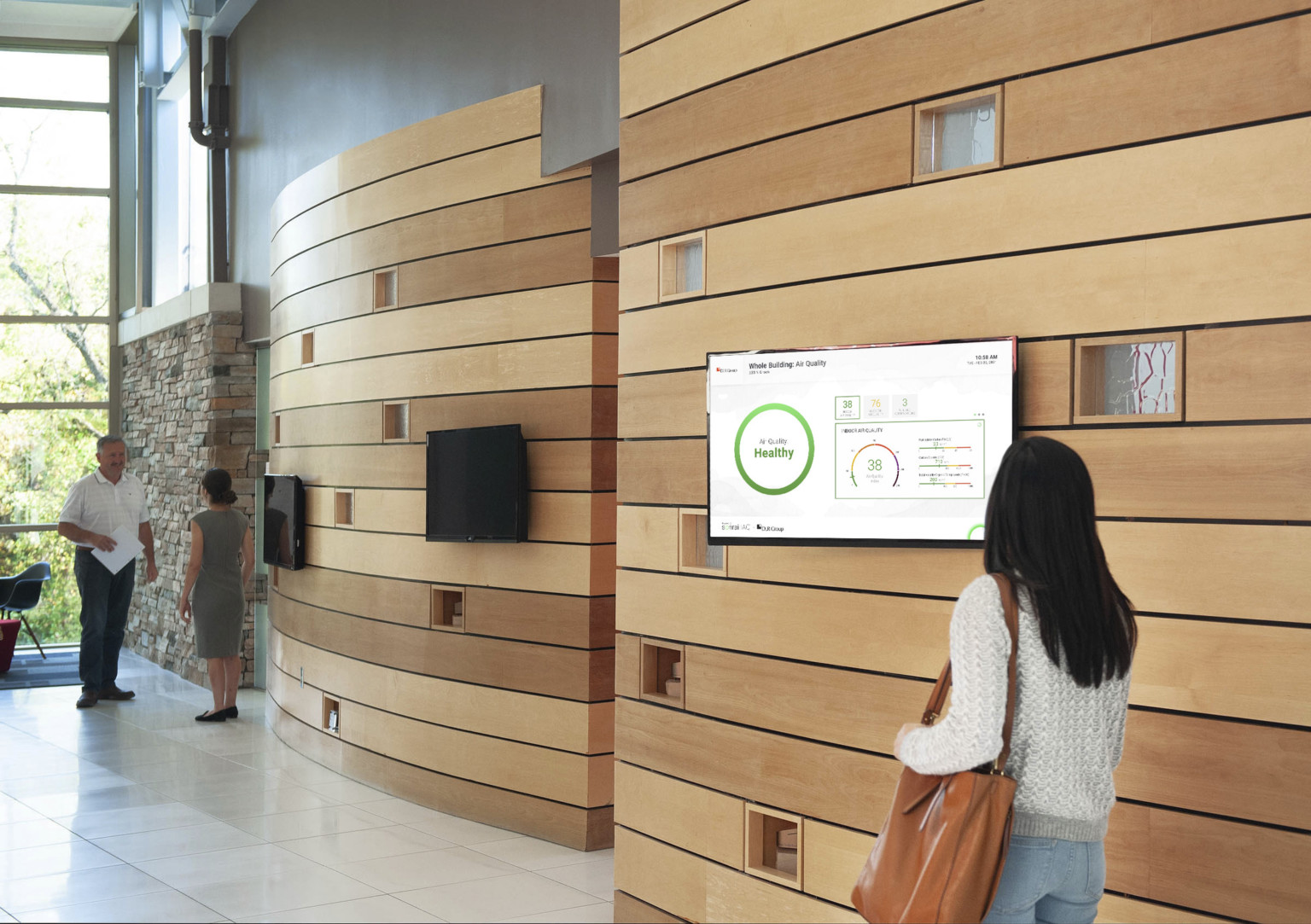
Healthy Air in Action

This awareness has translated into a worldwide push for improvements from both public and private entities to achieve healthier air both outdoors and indoors. Continuous monitoring of air quality to benchmark against leading industry standards is one of the first steps to better understand and prioritize opportunities for enhanced filtration, increased ventilation and intelligent automation for optimized control to enable a smart and healthy built environment.
As we enter into a new normal post-pandemic, minimum expectations demand transparency in both outdoor and indoor air quality data, and the carbon emissions associated with delivering and maintaining high-performance environments. Air quality levels that were previously only seen in healthcare or world class facilities are now par for the course expectations for commercial real estate today.
As an integrated design firm, we take a holistic approach to optimizing building performance during design, construction and post-occupancy into long term operations. As our building codes trend from prescriptive and simulated performance compliance, towards outcome-based compliance paths, and as our sustainability ratings trend from feature-based ratings towards performance-based standards (i.e. RESET Air, WELL Performance Rating etc.), how a building operates post-occupancy has taken on more significance to designers, contractors, and owners than ever before.
As a further step towards providing a source of truth for key performance indicators established early in the design process, and to enable an evidence-based approach to design performance verification, we developed an industry leading intelligent air quality analytics app to track healthy building metrics, occupant comfort and the carbon emissions associated with maintaining high-performing indoor environments.
For Air Quality Awareness Week and a time that our team of architects, engineers, building analysts, data scientists, and interior designers can share more about how their work impacts air quality.
Here are just a few of the ways to impact your air quality.
- Plan and Design
- Validate and Certify
- Optimize and Maintain
- Clean Energy
- Share and Educate
1. Plan and Design
We start by building on the EPA’s Clean Air Buildings Challenge and the resources for those who want to improve their indoor air quality. When considering continuous air quality monitoring, it is important to begin with selecting sensors that best fit your needs, then considering the data you want to monitor.
Assessing building readiness and resilience and designing your space for optimal air quality requires a holistic approach that includes ventilation, filtration, and cleaning considerations.
Our interior designers are always highly considerate in making material selections to minimize off-gassing from building furnishings, as part of a wholistic and integrated design approach for air quality. Making the best choice of materials early in the design process is key.

“We have more data confirming VOC and TVOC ranges today than ever before. However, there are still many reporting gaps for building materials’ verified content or emissions, and the role they plan in air quality impact. Increased demand in air quality visibility and optimization has a critical ripple effect for materials transparency and optimization,” Stephanie says.
2. Validate and Certify
Getting a baseline assessment of your building’s indoor air quality is a key step in achieving measurable improvements.

“You can’t improve what you can’t measure,” Coral says. “Giving clients the means to not only monitor indoor air quality but make the data accessible and transparent to occupants is key in designing high performing healthy buildings.”
The RESET Air Standard is the world’s first sensor-based and performance-driven data standard and certification program for the built environment. This standard/certification is a great way to provide 3rd party validation on the air quality metrics being communicated to both building occupants in order to foster a culture of trust and transparency, and to facilities management teams to enable a proactive approach to Operations and Maintenance in high-performing buildings.
3. Optimize and Maintain
HVAC inspections, testing and balancing, continuous monitoring and HVAC systems commissioning are great ways to gain the insights needed for prioritizing capital improvement planning and maintenance.

“Through continuous monitoring and data transparency we can empower occupants to understand and troubleshoot their instinctive reaction to indoor environmental quality,” Jason says. “It allows us to decide where we want to spend our time indoors – something that is even more important in choice-based work environments.”
Utilizing BAS & IoT sensors for a monitoring-based commissioning approach enables facility management teams to gain deeper insights into building performance, system patterns and anomalies in operational data, which can be addressed proactively. The bar for operational excellence is higher than ever before, and this level of smart building analytics is critical to success.
4. Clean Energy
Diversifying energy sources to include renewables is a great way to support greenhouse gas reduction goals which improves air quality. Our engineers designed solar projects ranging from small carports to 300MW utility-scale ground-mount arrays. See how we helped the visitors center at Mount Rushmore operated by Xanterra Travel achieve their goals through solar energy production by viewing their live data dashboard.

“Renewable energy deployment raises awareness and demonstrates an overarching commitment to all aspects air quality both direct and indirect,” says Renewable Energy Leader and Principal John Weiskopf, PE, SE.
Our commitment to the environment is outlined in our Sustainability Action Plan. The industry is shifting to more sustainable electrification solutions instead of the once commonplace fossil fuel consuming energy sources.
5. Share and Educate
Sharing air quality data with building occupants is critical to fostering trust and transparency. We pioneered this approach in the US in 2016 by deploying air quality monitors and RESET certifying our own portfolio through our healthy spaces initiative.
Sharing data with facility managers provides them with valuable insights for optimization and intelligent automation and enhanced optimization to balance air quality, occupant comfort and the energy resources required to maintain that optimal environment.
Sharing building health metrics to building owners and investors has become a key differentiator to organizations with environmental, social and governance reporting commitments. This past year we were able to support Sterling for Sterling Bay’s commitment to the RESET Air Standard and advance their ESG commitments.
As sharing data trends from voluntary to mandatory as we are seeing today with energy and carbon emissions with ordinances like Local Law 97 in NYC and with Boston’s updated Building Emissions Reduction and Disclosure Ordinance, also referred to as BERDO, there has never been a greater need for organized, investment grade building performance data to validate and optimize building performance.










